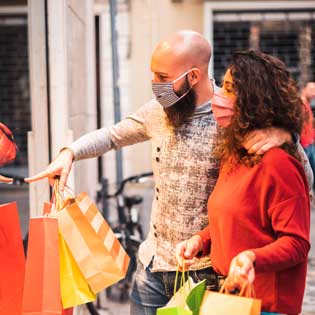
Traditions are important, and Christmas is many things to many people. Despite a media focus on Christmas which makes it seem like something universally celebrated, it is worth remembering that we live side-by-side with non-celebrants, as well as religious celebrants and cultural celebrants.
Though atheist Richard Dawkins once called himself a ‘cultural Christian’ when it comes to Christmas traditions like singing carols, not everyone joins in with cultural traditions, and equally not everyone excludes religious meaning in preference for the cultural.
Society is diverse, though Christmas as a season is not always good at recognising that. Whatever its meaning, or lack thereof, the focus on Christmas tells us something about society and gives us a kind of window into what matters to people in the deep midwinter. It can often seem that what matters to people is consuming.
Christmas is a recycling bin, or worse, a landfill waiting to happen. We know that the planet will not be able to sustain our current levels of consumption and waste, yet when it comes to Christmas, it can seem that not much really changes year on year.
The current focus on Christmas in the media, and on the ability to celebrate in the pandemic, may reinforce the idea that Christmas this year will be ‘different’, but it still seems to affirm the basic assumption that the way to celebrate is to go out into the virtual, if not physical, marketplace and show care for loved ones through buying things and stocking up on celebratory food.
How can Christmas consuming, and our consuming practices year round, become more ethical? At the heart of ethical consuming is the notion of extending our concern and care for others beyond our nearest and dearest to those absent or distant others – the world’s poorest and most vulnerable – who are affected by our consuming practices, and to the environment shared by humans across the globe.
More radical changes to our practices are needed if we want to make significant advances toward sustainability goals. The UN has reported that the pandemic is reversing progress on SDGs which were already not on track for 2030, hitting the world’s poorest and most vulnerable hardest, with women ‘bearing the heaviest brunt of the pandemic’s effects’.
Though we may think of Christmas as traditional, in reality it is continually changing, and the present moment can be seen as an opportunity for greater change. A different societal emphasis on Christmas has the potential to do more to address the human and environmental cost of the holiday, and to play a small part in refocussing our attention with regard to collective practices all year.
Cultural and religious icons are worth employing toward the goal of considering the human and environmental cost of Christmas. Figures like Father Christmas have historically undergone constant change, from fourth-century bishop to Haddon Sundbloom’s 1930s ambassador for Coca-Cola and beyond. The classic red and white imagery of the film White Christmas (1954) may be over-due for a more dramatic change. The children’s book Santa Claus is Green! depicts Santa showing concern for the impact of Christmas, and reflecting, ‘The earth is so beautiful…The last thing I want to do is spoil it.’
Another classic Christmas icon, Scrooge, is re-imagined in Margaret Atwood’s book Payback, where Scrooge responds to ecological and economic disaster, asking ‘Where should I start?’. There is continuing potential in the Dickensian format of considering Christmas past, present, and – importantly – future.
Religious traditions and stories also undergo constant change, yet have sustainability in their own ways. There is potential to focus on the human side of the effects of consuming in our world (and effects on women in particular) by shifting attention from the male saviour in the manger to Mary.
Though Mary is often seen as the well-off Caucasian woman we may encounter in an art gallery, it is possible to envision her more as biblical scholar Gale Yee describes her – ‘a poor, brown-skinned, teen-age unwed mother from the boonies’. From this perspective, Mary’s song in the nativity narratives, known as the Magnificat, is all the more powerful, emphasising the lifting up of ‘the lowly’ and filling ‘the hungry with good things’.
Whether religious or cultural icons, figures such as these can be brought on board for a move toward more ethical approaches to consuming, their societal influence directed toward consideration of others and the environment.
As Donna Haraway says in her book Staying with the Trouble, ‘it matters what stories tell stories’ when it comes to consideration of the earth and its inhabitants. Keeping our stories and cultural icons of Christmas ‘the same’ is unlikely to lead to the kind of change we need in human and environmental terms.
Life in a pandemic can feel like being part of some sort of living story or parable, with many opportunities for ethical reflection. The distinction we have become familiar with between essential and non-essential shops perhaps presents the opportunity to more purposefully reflect on genuine need on our doorstep, and in global perspective, and to consider the impact of our levels of consumption and the choices we make.
It is possible to change what we see through the window on society that Christmas represents. Hopefully, when things return to ‘normal’, lessons will have been learned that are ‘not just for (this) Christmas’.
- Inches, A (2009) Santa Claus Is Green! How to Have an Eco-Friendly Christmas. New York: Simon & Schuster.
- Atwood M (2008) Payback: Debt and the Shadow Side of Wealth. London: Bloomsbury.
- Yee G A (2012) The Silenced Speak: Hannah, Mary, and Global Poverty. Feminist Theology 21(1): 40-57.
- Haraway D J (2016) Staying with the Trouble: Making Kin in the Chthulucene. Durham, NC: Duke University Press.